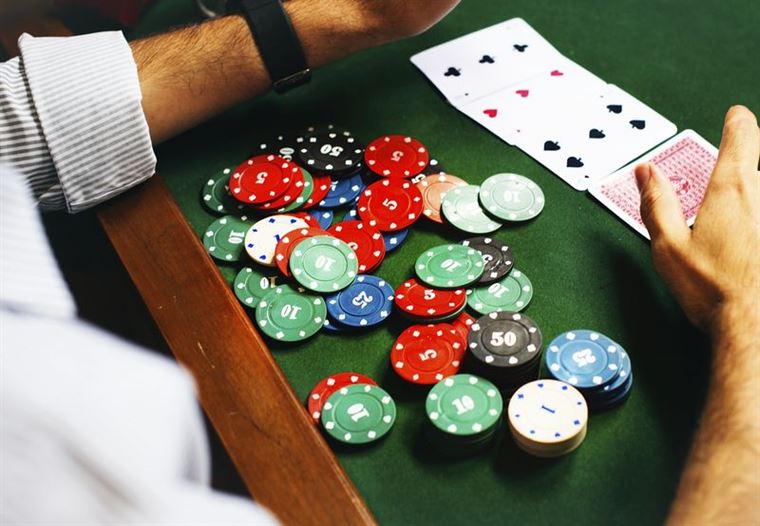The Language of Poker: Understanding Poker Jargon and Slang is a comprehensive guide that delves into the unique vocabulary and terminology used in the world of poker. This guide aims to help both novice and experienced players navigate through the often confusing and intricate language of the game. By providing clear explanations and examples, readers will gain a deeper understanding of poker jargon and slang, enabling them to communicate effectively and confidently in poker circles. Whether you’re a casual player or aspiring professional, this guide is an essential resource for anyone looking to enhance their poker knowledge and improve their overall gameplay.
The Origins of Poker Jargon: Tracing the Evolution of Poker Language
Poker has a rich history that dates back several centuries, and its language has evolved alongside the game itself. The origins of poker jargon can be traced back to the early days of the game, when it was played in saloons and on riverboats in the American West. The players and dealers developed their own vocabulary to describe the various aspects of the game, and this vocabulary has been passed down through the generations.
One of the earliest examples of poker jargon is the term “ante,” which refers to the small bet that all players must make before the cards are dealt. This term comes from the Latin word “ante,” which means “before.” Another early example is the term “bluff,” which refers to a player making a bet or raise with a weak hand in order to deceive their opponents into thinking they have a strong hand. This term likely comes from the Dutch word “bluffen,” which means “to brag or boast.”
As poker grew in popularity and spread across the United States, new terms and phrases were added to the poker lexicon. For example, the term “flop” refers to the first three community cards that are dealt face up on the table. This term likely comes from the sound that the cards make when they are dealt onto the table. Another example is the term “river,” which refers to the fifth and final community card that is dealt face up on the table. This term likely comes from the fact that the card is often dealt from the bottom of the deck, which is known as the “river.”
In addition to these specific terms, poker players also developed their own slang and shorthand to describe various situations and strategies in the game. For example, a player who is on a winning streak may be referred to as being “on a heater,” while a player who is consistently losing may be referred to as being “on tilt.” These terms and phrases add color and personality to the game, and they are often used to convey a certain attitude or emotion.
In recent years, the language of poker has continued to evolve with the rise of online poker. Online players have developed their own unique vocabulary to describe the various aspects of the game, such as “donk betting” (making a small bet into a large pot) and “nit” (a player who plays very conservatively and only bets with strong hands). These terms and phrases have become widely used in the online poker community and are now part of the larger poker lexicon.
Decoding Poker Jargon: A Beginner’s Guide to Understanding Poker Terms
One of the first terms you will encounter in poker is “blinds.” Blinds are forced bets that players have to make before the cards are dealt. The player to the left of the dealer is the small blind, and the player to the left of the small blind is the big blind. These bets ensure that there is always money in the pot, creating action right from the start of the hand.
Another important term in poker is “hand.” A hand refers to the set of cards that a player holds during a particular round. Each player is dealt a certain number of cards, depending on the variation of poker being played. The strength of a player’s hand is determined by the combination of cards they hold.
When it comes to evaluating the strength of a hand, the term “hand ranking” comes into play. Hand ranking refers to the hierarchy of poker hands, from the highest to the lowest. The highest-ranking hand in most poker variations is the royal flush, which consists of the Ace, King, Queen, Jack, and Ten of the same suit. On the other end of the spectrum, the lowest-ranking hand is typically a high card, where the player’s hand does not form any meaningful combination.
Moving on, let’s talk about “betting.” Betting is a fundamental aspect of poker, where players wager money on the strength of their hand. There are different types of bets in poker, including “check,” “call,” “raise,” and “fold.” When a player checks, it means they choose not to bet, passing the action to the next player. Calling involves matching the current bet, while raising means increasing the bet. Folding, on the other hand, is when a player decides to forfeit their hand and not participate in the current round.
In addition to these terms, poker players often use slang to describe certain situations or actions. For example, “fish” is a term used to describe a weak or inexperienced player. On the other hand, a “shark” refers to a highly skilled and experienced player. Other common slang terms include “tilt,” which describes a player’s emotional state when they are frustrated or angry, and “rivered,” which means losing a hand on the final community card.
Understanding the language of poker is crucial for effective communication at the table. It allows players to discuss strategies, analyze hands, and make informed decisions. By familiarizing yourself with the jargon and slang used in poker, you will be able to navigate the game with confidence and improve your overall poker skills.
The Language of Tells: How Poker Jargon Helps Identify Player Behavior
One common tell that poker players use is the “nervous twitch.” This is when a player displays a physical tic or movement that indicates they are feeling anxious or uncomfortable. It could be something as simple as tapping their fingers on the table or scratching their nose. These nervous twitches can be a sign that a player is bluffing or has a weak hand. By recognizing these tells, you can adjust your strategy accordingly and potentially win more pots.
Another tell that is often used in poker is the “eye contact tell.” This is when a player avoids making eye contact with their opponents. It is believed that avoiding eye contact is a sign of weakness or deception. By not looking their opponents in the eye, players hope to avoid giving away any information about the strength of their hand. However, experienced players can often pick up on this tell and use it to their advantage. If a player is avoiding eye contact, it may be a sign that they are bluffing or have a weak hand.
One of the most well-known tells in poker is the “chip shuffle.” This is when a player nervously shuffles their chips while contemplating their next move. The chip shuffle is often seen as a sign of strength, as it indicates that a player is confident and in control. However, some players use the chip shuffle as a bluff, hoping to deceive their opponents into thinking they have a strong hand. By paying attention to the chip shuffle, you can gain valuable insights into a player’s mindset and make more accurate reads on their hand.
In addition to these physical tells, there are also verbal tells that can give away information about a player’s hand. One common verbal tell is the “hesitation tell.” This is when a player hesitates before making a bet or a raise. It is believed that hesitation is a sign of uncertainty or weakness. By recognizing this tell, you can exploit your opponents’ indecision and make more profitable decisions at the table.
Poker Slang Around the World: Exploring Cultural Variations in Poker Language
One of the most well-known variations of poker is Texas Hold’em, which originated in the United States. As a result, much of the poker slang used in English-speaking countries can be traced back to American roots. For example, terms like “flop,” “turn,” and “river” are commonly used to describe the community cards that are dealt during a hand. Additionally, phrases like “all-in,” “bluff,” and “pocket rockets” have become part of the lexicon for poker players worldwide.
Moving across the Atlantic, we find that poker slang in Europe has its own distinct flavor. In France, for instance, the term “carré” is used to describe a four-of-a-kind hand, while in Germany, players might refer to a full house as a “boat.” These regional variations in poker language not only add color to the game but also reflect the unique cultural nuances of each country.
In Asia, where poker has gained immense popularity in recent years, there are also notable differences in poker slang. In China, for example, players often use the term “monkey” to refer to a face card, while in Japan, the phrase “yakuza” is sometimes used to describe a straight flush. These linguistic idiosyncrasies highlight the influence of local customs and traditions on the language of poker.
Beyond these specific examples, it is important to note that poker slang is constantly evolving and adapting to new trends and influences. With the rise of online poker and the global nature of the game, players from different countries are interacting more than ever before. This increased interaction has led to the emergence of a shared poker language that transcends borders and incorporates elements from various cultures.
From the Felt to the Online Tables: Poker Jargon in the Digital Age
One of the most common terms you’ll hear in online poker is “the felt.” This refers to the virtual poker table where players gather to play. While in traditional poker, players would physically sit around a felt-covered table, in online poker, the felt is a digital representation of the table. The term “felt” has become synonymous with the online poker experience, and players often refer to their time spent playing as “being on the felt.”
Another term that has gained popularity in the digital age is “the rail.” In traditional poker, the rail refers to the area around the poker table where spectators gather to watch the game. In online poker, the rail refers to the chat box where players can interact with each other and discuss the game. It’s a virtual gathering place where players can share their thoughts, strategies, and even engage in friendly banter. The rail has become an integral part of the online poker experience, allowing players to connect with each other in ways that were not possible before.
When it comes to online poker, one term that you’ll often hear is “the nuts.” In poker, the nuts refers to the best possible hand at any given moment. In online poker, players will often use the term to describe a particularly strong hand that they hold. For example, if a player has pocket aces, they might say that they have “the nuts.” This term has become ingrained in online poker culture and is used to convey confidence and strength in one’s hand.
Another term that has become popular in online poker is “tilt.” Tilt refers to a state of emotional frustration or anger that can affect a player’s decision-making abilities. In traditional poker, players can often see when their opponents are on tilt by observing their body language and facial expressions. In online poker, however, players must rely on other cues, such as betting patterns and chat messages, to determine if their opponents are on tilt. Recognizing when a player is on tilt can give you a significant advantage in the game.
Finally, one term that has become synonymous with online poker is “bad beat.” A bad beat refers to a situation where a player with a strong hand loses to a player with a weaker hand due to luck. In online poker, bad beats are more common due to the sheer volume of hands that are played. Players often share their bad beat stories on the rail, commiserating with each other over their unfortunate losses. It’s a way for players to bond and find solace in the shared experience of the ups and downs of poker.
In conclusion, the language of poker has evolved with the rise of online poker. Terms like “the felt,” “the rail,” “the nuts,” “tilt,” and “bad beat” have become part of the lexicon of online poker players. Understanding these terms is essential for anyone looking to navigate the digital poker landscape. So, whether you’re a seasoned player or just starting out, familiarize yourself with the jargon of online poker and join the conversation on the virtual felt.




